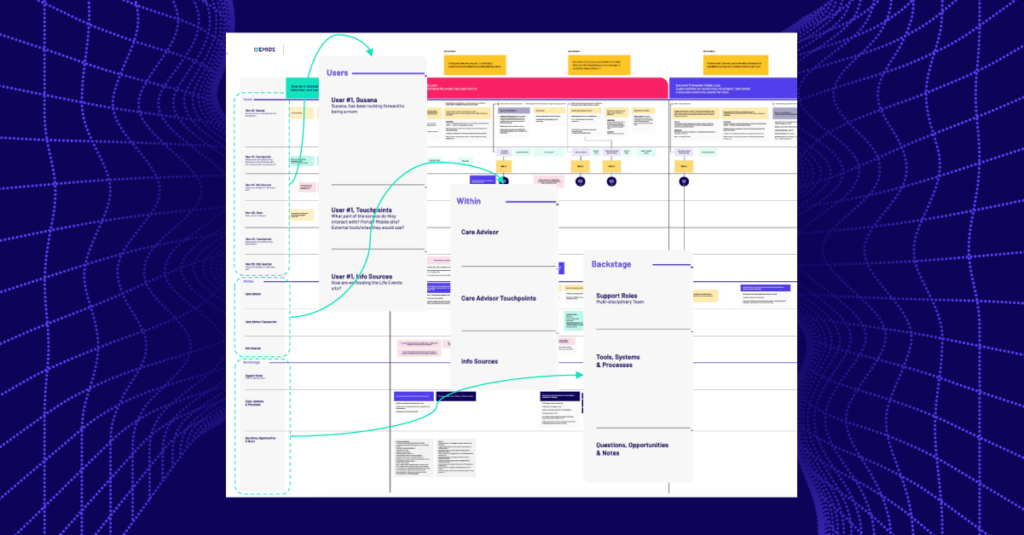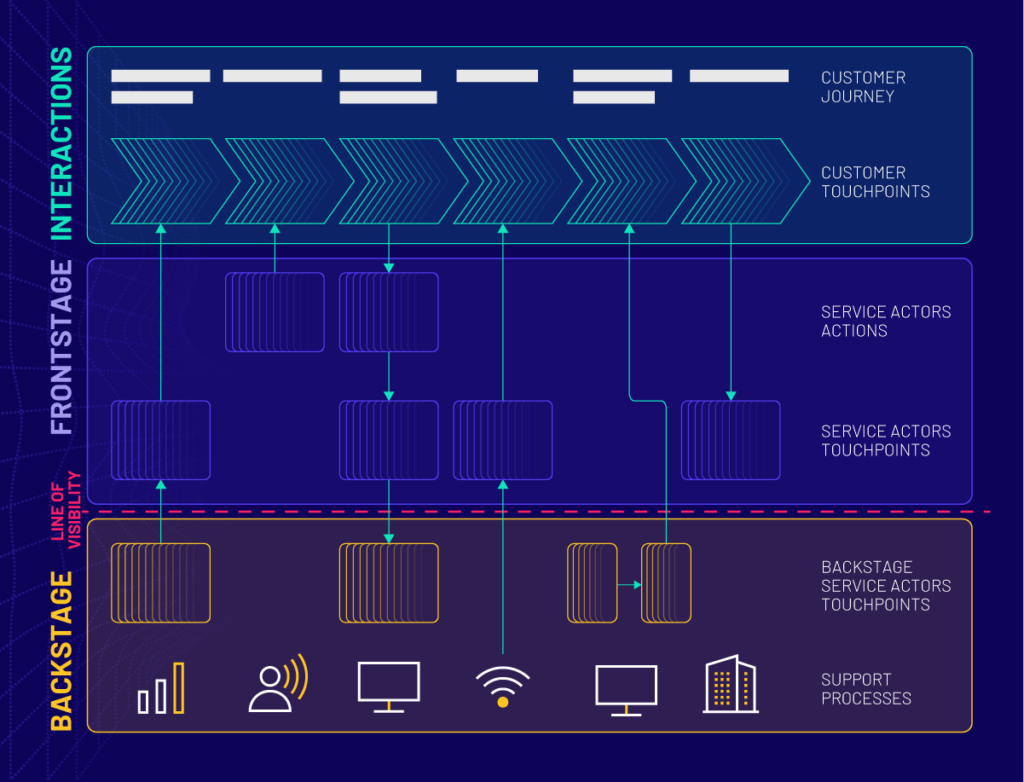In the ever-evolving landscape of healthcare, digital transformation is essential for enhancing patient care, improving efficiency, and reducing costs. As organizations seek ways to improve their digital services to better serve their customers, its paramount to align them with your business objectives. However, navigating this journey can often feel like exploring uncharted waters.
Enter Service Design—a powerful approach that places users at the heart of the design process while ensuring efficiency, effectiveness, and alignment with business goals.
What is Service Design?
Service design is a human-centered approach to crafting services that resonate with users and drive business success. At its core, service design involves defining a service’s value proposition and designing interaction and operating models that cater to both your customer needs and your business objectives. This work results in more intentional and well-orchestrated service components (touchpoints, information, people, etc.) that deliver better outcomes for all service participants (customers, employees, and other stakeholders).
Caroline Zenss
Lead Interaction Designer
Service Design Benefits
To fully appreciate the impact of service design, it’s important to delve into the specific advantages it brings to both businesses and their clients. Each of these elements plays a crucial role in not only aligning with your objectives but also in sustaining a competitive advantage in a rapidly evolving market.
- Improved Customer Experience: Service design focuses on understanding the entire customer journey. By identifying pain points and opportunities for improvement, you can enhance the overall patient experience.
- Enhanced Efficiency and Cost Saving: By mapping out current processes, you can figure out solutions to streamline operations, reduce wait times and minimize administrative burdens. This can result in cost savings by reducing overhead expenses and improving resource allocation.
- Increased Patient Engagement and Satisfaction: By involving stakeholders early on, you can create solutions that better meet their needs and preferences.
- Support for Innovation and Differentiation: Service design enables you to develop innovative services and solutions that will attract new patients, retain existing ones, and build a reputation for delivering high-quality, patient-centered care.
Enter the Service Blueprint
Service blueprints play a crucial role in service design; they provide a comprehensive view that combines the user journey with all the elements from the business that impact the customer’s experience. It serves as a roadmap, guiding the design and improvement of services by visualizing the entire service ecosystem—from touchpoints to backend processes.

Why Service Blueprinting Matters
- Visualize your Service: A blueprint offers a holistic view of the service, bridging the gap between the customer experience and the business experience.
- Identify Issues and Opportunities in your Service to patients: By mapping out the service process, including touchpoints, a blueprint helps pinpoint pain points, bottlenecks, and areas ready for enhancement.
- Facilitate Cross-Functional Collaboration: Acting as a common language for multiple teams, a blueprint fosters collaboration and ensures a shared understanding across departments.
- Enhance Service Design and Innovation: With a blueprint in hand, you can design and create services that meet customer needs while aligning with business objectives.
- Optimize Operational Efficiency: By streamlining frontstage and backstage processes, a blueprint uncovers opportunities to enhance operational efficiency and improve service delivery.
- Drive Customer-Centricity: Rooted in understanding and addressing customer needs, a blueprint fosters a customer-centric mindset and culture within your organization.
Components of a Service Blueprint
Understanding the intricacies of a service blueprint is essential for optimizing your service delivery and ensuring a seamless customer experience. In this section, we dissect the key components of a service blueprint, offering a comprehensive view of how each element contributes to the overall design.
By delineating the front-stage interactions, backstage operations, and the line of visibility that separates them, we shed light on the invisible mechanisms that drive exceptional service and organizational efficiency.

- Customer: The customer is placed at the top, with their actions and touchpoints broken down into steps.
- Front Stage: This component constitutes everything the customer directly sees and interacts with. The actors the customer interacts with can be a provider, a health plan, an e-commerce company, etc. For each actor, a list of actions and touchpoints is provided for each step of the customer’s journey.
- Backstage: This includes everything that happens behind the scenes to support the front stage but is invisible to the customer. It includes the same actors as the front stage. For each actor, a list of behind-the-scenes actions and processes is provided. Components such as Capabilities, Regulation/Policy and KPI lanes may be included to the backstage, as they are invisible to the patient.
- Line of Visibility: The boundary separating patient-facing interactions (frontstage) from internal operations (backstage).
When to Leverage Service Blueprinting
Whether you’re just beginning or well into development of a new digital solution, it’s always the right time to initiate the blueprinting process.
- During Discovery: Blueprints are an efficient tool to understand the current state of the service and identify opportunities for improvement or innovation.
- As part of Design & Development: Blueprints are a starting point to designing new services or refine existing ones based on insights gathered during discovery.
- During Implementation & Optimization: Blueprints will guide the execution of designed services for continuous improvement and operational efficiency.
Examples of Service Design at Work
Pharmacy Benefits Management
In a major project to improve specialty pharmacy services, we worked with a pharmacy benefits management company, first focusing on understanding how patients, healthcare providers, pharmacies, and the client interact.
By holding workshops and working closely together, we examined every part of the process to find weaknesses and opportunities for improvement. This effort brought everyone together to create a new, shared vision for the future of specialty pharmacy services, aiming to provide excellent patient care throughout the process.
The Service Design Blueprint not only provided a snapshot of the current situation but also evolved into a valuable instrument that facilitated collaboration among various teams and stakeholders. It steered their attention toward addressing future requirements and mapping out subsequent actions.
Health and Well-being Company
This health and well-being company used service design to improve how they offer care to their members, particularly those going through significant life events like becoming a parent or moving. With our help, they developed easy-to-follow care checklists that members could access through the company’s online portal. These checklists were designed to be engaging and helpful, initially for certain health plan members, with plans to expand these services to others in the future.
The team created a prototype—a test version of the online experience—that showed what essential features should be included initially (MVP) and what could be added later (Beyond MVP). They also made a playbook to guide the future development of these services.
The result was a service that not only made it easier for members to understand what benefits and support were available to them during tough times but also helped the company’s care advisors provide better support.
Conclusion
At Emids, we recognize the transformative power of service design and blueprinting. By leveraging these tools, we empower organizations to create user-centric, efficient, and effective digital services that drive meaningful outcomes for both customers and businesses.
For expert guidance on service design with your product, contact our UX and Strategy Team.

